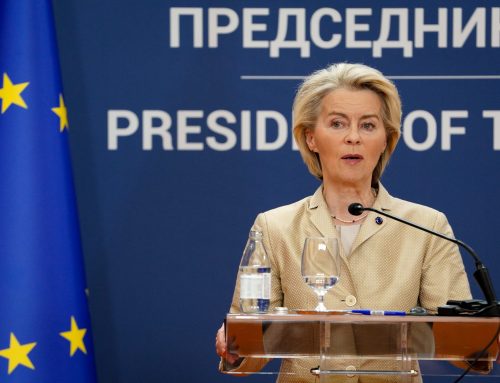In 2014, 122 million people, or 24.4% of the population, in the European Union (EU) were at risk of poverty or social exclusion. These figures come from Eurostat, the statistical office of the European Union. The risk of poverty or social exclusion affected 1 in 4 persons in the EU in 2014.
This means that they were in at least one of the following three conditions: at-risk-of-poverty after social transfers (income poverty), severely materially deprived or living in households with very low work intensity. After a slight decrease in 2013 following three consecutive years of rise, the proportion of persons at risk of poverty or social exclusion in the EU remains in 2014 nearly stable but higher than its 2008 level (23.8%). The reduction of the number of persons at risk of poverty or social exclusion in the EU is one of the key targets of the Europe 2020 strategy.
Highest at risk of poverty or social exclusion rate in Romania, lowest in the Czech Republic
In 2014, more than a third of the population was at risk of poverty or social exclusion in three Member States: Romania (40.2%), Bulgaria (40.1%) and Greece (36.0%). At the opposite end of the scale, the lowest shares of persons being at risk of poverty or social exclusion were recorded in the Czech Republic (14.8%), Sweden (16.9%), the Netherlands (17.1%), Finland (17.3%) and Denmark (17.8%).
Largest decrease in the at-risk-of-poverty or social exclusion rate in Poland, highest increase in Greece
Among Member States for which data are available, the at-risk-of-poverty or social exclusion rate has grown from 2008 to 2014 in fourteen Member States, with the highest increases being recorded in Greece (from 28.1% in 2008 to 36.0% in 2014, or +7.9 percentage point), Spain (+4.7 pp), Cyprus (+4.1 pp), Malta (+3.7 pp), Hungary (+2.9 pp) and Italy (+2.8 pp). In contrast, the largest decreases among Member States without break in time series were observed in Poland (from 30.5% to 24.7%, or -5.8 pp), Romania (-4.0 pp) and Slovakia (-2.2 pp). At EU level, the percentage of total population being at risk of poverty or social exclusion has risen from 23.8% in 2008 to 24.4% in 2014.
17% of the population in the EU at risk of income poverty…
Looking at each of the three elements contributing to being at risk of poverty or social exclusion, 17.2% of the EU population in 2014 were at risk of poverty after social transfers, meaning that their disposable income was below their national at-risk-of-poverty threshold (see the corresponding table). This proportion of persons at risk of income poverty in the EU has increased compared with 2013 and also with 2008 (both 16.6%). As the thresholds reflect actual income distribution in the countries, they vary greatly between Member States and also over time. Across the EU Member States for which data are available, more than 1 in 5 persons was at risk of income poverty in Romania (25.4%), Spain (22.2%), Greece (22.1%), Bulgaria (21.8%) and Latvia (21.2%). The lowest rates were observed in the Czech Republic (9.7%), the Netherlands (11.6%) and Denmark (11.9%). Compared with 2008, the proportion of persons at risk of income poverty has increased in eighteen Member States for which data are available, and has decreased in five.
…9% severely materially deprived…
In the EU in 2014, 8.9% of the population were severely materially deprived, meaning that they had living conditions constrained by a lack of resources such as not being able to afford to pay their bills, keep their home adequately warm, or take a one week holiday away from home. This proportion of persons severely materially deprived in the EU has decreased compared with 2013 (9.6%) but remains higher than in 2008 (8.5%). The share of those severely materially deprived in 2014 varied significantly among Member States for which data are available, ranging from more than 20% of the total population in Bulgaria (33.1%), Romania (26.3%), Hungary (23.9%) and Greece (21.5%), to 5% or less in Sweden (0.7%), Finland (2.8%), Denmark and the Netherlands (both 3.2%), Austria (4.0%), France (4.8%) and Germany (5.0%). Compared with 2008, the proportion of persons severely materially deprived has increased in eleven Member States for which data are available, and decreased in twelve.
…and 11% living in households with very low work intensity
For low work intensity, 11.1% of the population aged 0-59 in the EU lived in households where the adults worked less than 20% of their total work potential during the past year. This proportion has constantly increased in the EU since 2008. In 2014, Greece (17.2%), Spain (17.1%) and Belgium (14.6%) had the highest proportions of those living in very low work intensity households, while Sweden and Romania (both 6.4%), Slovakia (7.1%), Poland (7.3%) and the Czech Republic (7.6%) had the lowest among Member States for which data are available. Compared with 2008, the share of persons aged 0-59 living in households with very low work intensity has increased in nearly all Member States, except in Germany, Poland and Romania.
The at-risk-of-poverty rate is the share of people whose total household income (after social transfers, tax and other deductions) that is available for spending or saving is below the at-risk-of-poverty threshold, which is set at 60 % of the national median equivalised disposable income after social transfers.
This indicator does not measure wealth or absolute poverty, but low income in comparison to other residents in that country.
The threshold depends on the income distribution in a country for a given year and varies with the composition of a household. It is therefore important to note that the at-risk-of-income-poverty rate is a relative measure of poverty and that the threshold varies greatly between Member States. It also varies over time as it follows the evolution of the national median disposable income: in a number of Member States the threshold has fallen over the period 2008-2014 (Greece, Cyprus) or stayed nearly stable (Spain, Italy and Portugal) due to the economic crisis.




